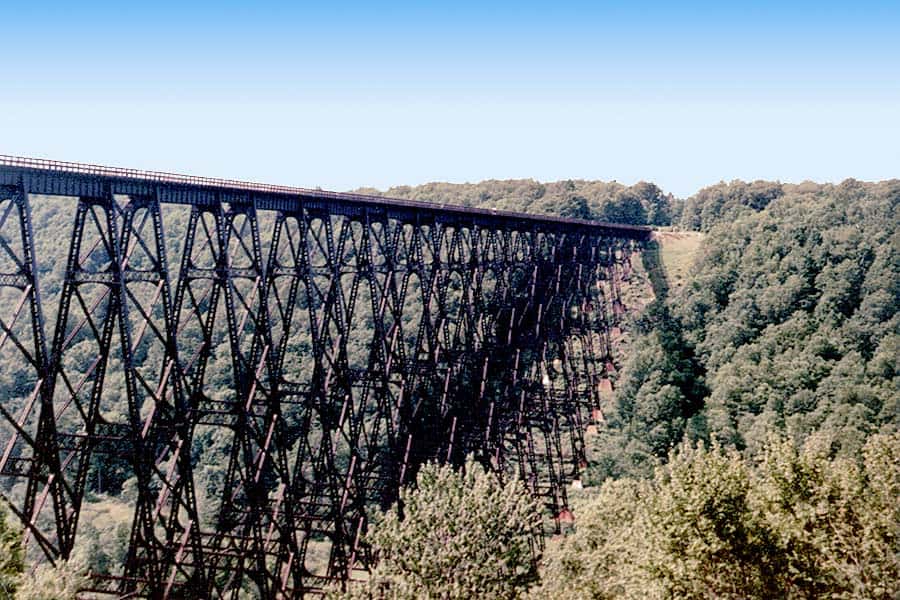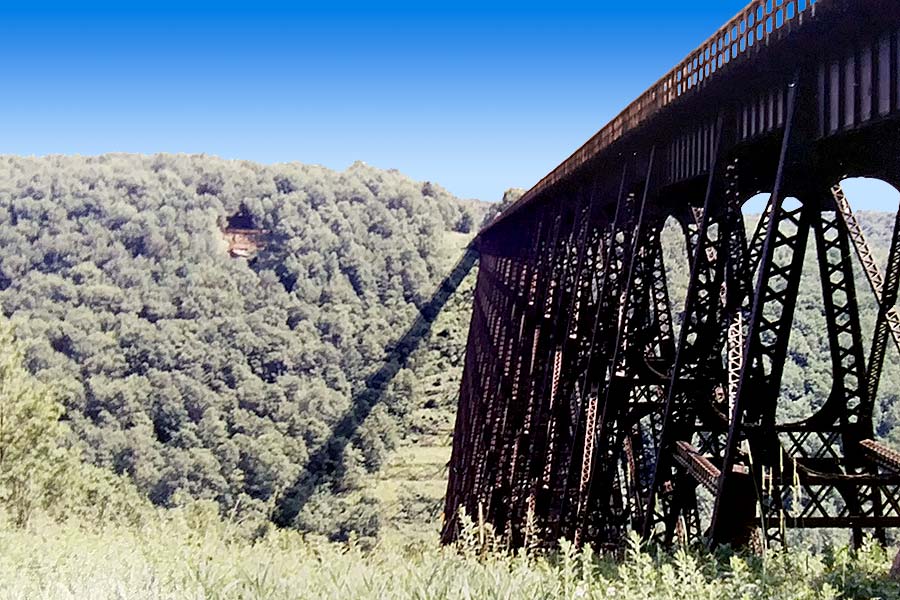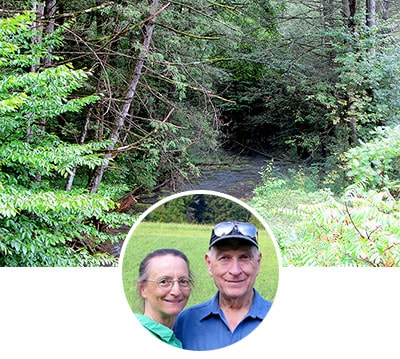
For decades, the Kinzua Railroad Bridge was a vital piece of railroad infrastructure in northcentral Pennsylvania. But, unfortunately, now a majority of it lays crumpled on the valley floor. So what happened to the Kinzua Railroad Bridge?
In 2003, a mesoscale convective system struck the Kinzua Valley. This large storm spawned an F1 tornado just up the valley from the Kinzua Railroad Bridge. The tornado generated winds of almost 100 miles per hour, which struck the bridge broadside, destroying several support towers and collapsing the bridge.
So how long and tall was the Kinzua Railroad Bridge? Why did trains stop using it? Why was it never rebuilt? In the following sections, you’ll find the answers to these questions and more about this remarkable bridge.
The Kinzua Railroad Bridge
In the late 1800s, Pennsylvania was booming. The state’s rich natural resources and growing population of ready-to-work immigrants contributed to massive growth in industry, especially as the second industrial revolution took hold. The second industrial revolution saw significant developments in manufacturing and rail technology.
These massive developments were fueled by coal. Coal powered everything from the locomotives that pulled freight to the massive steel mills that turned iron ore into usable materials.
Access to coal was critical for industry to thrive, and so it was that in 1882, the New York, Lake Erie, and Western Railway – also known as the NYLE&W – found itself looking for a way to connect the rich coalfields of Elk County with their main lines near Bradford.

The railroad had two options: build 8 miles of track that wound through challenging terrain or construct a bridge over the Kinzua Valley. Despite the vast size of the valley, the railroad determined that bridging the valley was better than building 8 miles of complex tracks. And so it was that the NYLE&W contracted with famed engineer Octave Chanute and the Phoenix Iron Works to build the first Kinzua Railroad Bridge.
When completed, the Kinzua Railroad Bridge was the longest and tallest railroad bridge in the world. In fact, promoters advertised the bridge as the Eighth Wonder of the World, and railroads offered novelty train rides where passengers from places like New York City, Pittsburgh, and Buffalo would take rides across the bridge.
These rides were likely quite thrilling. The bridge was built on enormous pylons and stood 300 feet from the floor of the valley. As a result, the bridge would often vibrate under the weight and motion of the locomotives, and the wind blowing through the valley was often quite stiff. Between the vibration and the wind, crossing the bridge was likely a scary, heart-pounding experience, a roller-coaster for adrenaline junkies of the late 1800s.
Bridge 2.0
The ceaseless march of time and progress soon led to the development of longer, heavier trains powered by bigger and stronger locomotives. By the mid-1890s, the average freight train was 85% heavier, and the Kinzua Railroad Bridge was soon obsolete: the bridge could no longer safely carry the massive weight of the locomotives that crossed it. It was time to rebuild the bridge.

On May 14, 1900, the last train crossed the original Kinzua Railroad Bridge. Next, crews began dismantling the old bridge and replacing it with a new structure made of modern steel. Construction was done tower-by-tower, with each new tower taking about a week to complete. Finally, the bridge was completely renovated and opened to rail traffic again on September 25, 1900.
For 59 years, trains ran across the Kinzua Valley on the modern steel bridge. However, the bridge was expensive to maintain and still required trains to slow significantly to cross the span. When the Erie Railroad obtained rights to use nearby tracks owned by the Baltimore & Ohio Railroad in the 1950s, the bridge’s days were numbered. The last train crossed the bridge in October of 1959, after which the bridge was taken out of service.
After being decommissioned in 1959, the bridge was purchased by the Kovalchik Salvage Company, which originally intended to scrap the bridge.
However, the head of the Kovalchik Salvage Company became enamored of the bridge after learning about its history and importance to the growth of northern Pennsylvania and decided that it was too unique and important to be dismantled for scrap. Instead, he worked with community groups who wanted to save the bridge, and in 1963, the bridge and its surrounding lands became Kinzua Bridge State Park, another of Pennsylvania’s free-to-visit state parks.
The state park was opened to the public in 1970 and saw multiple improvements over the years. From 1987 until 2002, the Knox and Kane Railroad operated sightseeing trains that crossed the bridge, giving modern people the chance to experience the same thrills as their ancestors. However, in 2002, the structure was determined to be at risk to high winds and was closed to all traffic.
Keystone Answers Fun Fact: The original Kinzua Railroad Bridge could safely handle loads up to 241 tons. Modern locomotives often weigh more than 200 tons on their own, and empty freight cars usually weigh about five tons; a single modern locomotive pulling one freight car could easily exceed the structural limits of the original bridge!
The End of the Kinzua Railroad Bridge
This decision turned out to be quite prescient. In 2003, construction crews were working to restore the bridge and reinforce certain structural elements that had been identified as needing work. Then, on July 21, 2003, just as the construction crew was leaving, a severe storm struck the area.
Amidst the thunderstorms and lightning, a small tornado touched down about a mile from the bridge. The F1 twister churned up massive winds with speeds of almost 100 miles per hour, which whipped down the valley and struck the bridge broadside.

The 10th and 11th support towers of the bridge collapsed almost immediately. Other towers were ripped off their anchors and tossed aside before being crushed by inflowing winds. In less than thirty seconds, the 103-year-old bridge was destroyed.
Support towers, rail sections, and wood littered the valley floor, a testament to the power of the forces of nature. Fortunately, nobody on the construction crew was injured; there was no loss of life in the Kinzua Bridge collapse.

How Long and Tall was the Kinzua Railroad Bridge?
The Kinzua Railroad Bridge stood 301 feet tall. That’s pretty tall — the State of Liberty stands 305 feet tall, meaning that it could almost fit under the Kinzua Railroad Bridge! Another way to think about the height of the bridge is that it’s about as tall as a 30-story building. Before its collapse, it was the fourth-highest rail bridge in the United States.
The Kinzua Bridge was not just tall; it was long. When it was operational, the Kinzua Railroad Bridge spanned 2,052 feet, which is almost half a mile in length.
When Did Trains Stop Using the Kinzua Railroad Bridge?
The original Kinzua Railroad Bridge was rebuilt in 1900 using improved materials and modern architecture. The final train to cross the original Kinzua Railroad Bridge ran the rails on May 14, 1900; the new bridge was opened on September 25, 1900.
From 1900 to 1959, the bridge saw regular rail traffic. However, the bridge was formally closed on June 21, 1959, after the Erie Railroad obtained rights to use an alternate route. The last train crossed the Kinzua Railroad Bridge in October of 1959, having been rerouted around an accident on the line’s new route.
After the cessation of commercial traffic, the bridge was mostly dormant. Between 1987 and 2002, the Knox & Kane Railroad offered train rides that crossed the Kinzua Railroad Bridge, allowing people to experience this amazing bridge for themselves. However, in 2002, these rides were stopped as engineers had identified structural problems with the bridge that posed serious safety hazards.
Why was Kinzua Railroad Bridge Never Rebuilt?
Initially, the state wanted to rebuild the bridge. However, the price tag for that project exceeded $45 million, which was an unpalatable sum of public money to rebuild a bridge that did not offer any tangible services.
So instead, the state reimagined the site as a Skywalk: visitors would be able to walk out onto the surviving track section to get a sense of the scope and scale of the bridge, learn about Pennsylvania’s history, and enjoy the beautiful views from the bridge deck.
The Skywalk opened in 2011. Today, visitors can walk to an observation deck with a glass floor, ramble about on hiking trails that lead to magnificent views of the valley and the bridge, and learn about how the bridge impacted both the railroads and the state of Pennsylvania.
The Kinzua Railroad Bridge is gone forever, but the Kinzua Bridge State Park will immortalize the history and significance of this impressive bridge for decades to come.
The Kinzua Railroad Bridge Lives On
The Kinzua Railroad Bridge was a vitally important piece of railway infrastructure. Without the bridge, transporting people and goods across the Kinzua Valley would have required trains to go miles out of their way over challenging terrain. It’s impossible to know what would have happened without the bridge, but it’s safe to say that the bridge contributed massively to the growth and success of industry in Pennsylvania and the broader United States.
When you head to Kinzua Bridge State Park and gaze out on the valley from the Sky Walk, take a moment and think about what the bridge represented. Not only did the bridge have a significant economic impact, but it was also a sign of the times. The Second Industrial Revolution brought massive change to the world, and the Kinzua Railroad Bridge was just one example of how innovations in engineering and materials science helped people achieve things never before thought possible.






